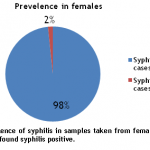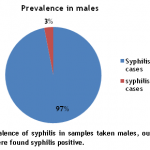Short Communication
Prevalence of syphilis in Pakistani blood donors
Shahid Nazir1*, Hafiza Saima Pracha2, Arman Khan1, Arslan Nazar1, Ahmed Fayyaz1, Muddasar Saeed Khan1, Shafique Ahmed3, Faiza Masood1, Tahir Yaqub1, Allah Rakha2
Adv. life sci., vol. 1, no. 1, pp. 27-30, November 2013
*Corresponding Author: Shahid Nazir (Email: shahidpiracha2009@yahoo.com)
Author Affiliations
2-University of Health Sciences, Lahore – Pakistan
3-National Centre of Excellence in Molecular Biology (CEMB), 87-west bank canal road, Lahore – Pakistan
Abstract
Introduction
Methods
Results
Discussion
References
Abstract
Background: Blood transfusion is one among the common sources for transmission of the infectious diseases. In Pakistan, a country of population about 1.8 billions, blood required for transfusion is approximately 1.5 million bags per year. So, evaluation of the prevalence of syphilis among the blood donors by a retrospective study is important and critical to give a vivid picture of current situation for both the donors involved and medical practitioners.
Method: A questioner was administered and consent was taken before obtaining the blood sample for the syphilis serology from all the blood donors. ARCHITECT syphilis Treponema Pallidum (TP) assay was performed to detect the syphilis.
Results: There were 449 (3.1%) confirmed cases found to be syphilis positive out of total 14,352 tested individuals. We found that male population is at far higher risk than female population. Out of 179 females, only 3 (1.6%) were found to be syphilis positive and out of 14173 males, 446 (3.1%) were having syphilis infection.
Conclusions: We report high prevalence of syphilis in blood donors which was unexpected as in accordance with the previous studies. This calls for mandatory syphilis screening test of donor before transfusion of blood. As this high prevalence poses a great risk to public health, we strongly suggest that there should me be more public awareness campaign to fight against this infectious disease.
Keywords: Syphilis, Treponema Pallidum, Serology, Prevelence, Blood donor
Introduction
Blood transfusion is among common sources for transmission of the infectious diseases [1]. In Pakistan, a country of population about 1.8 billion, blood required for transfusion is approximately 1.5 million bags per year from which 60% of the demand is being met by the private sector and 40 % by the public sector in the two big cities including Karachi and Lahore [http://www.emro.who.int/pak/programmes/blood-safety.html]. Safety and protection of human life are two major points adopted in blood transfusion globally after revelation of Transfusion Transmissible Infections (TTIs) [2]. One of the main threats to humanity are Sexually Transmitted Diseases (STD’s) those can lead to persistent disability, infertility issues, still birth, serious neonatal infections and can also be fetal [http://www.who.int/hiv/pub/sti/who_hiv_aids_2001.02.pdf]. Infections caused by STD’s like syphilis increase the chances of acquiring Human Immunodeficiency Virus (HIV) through sexual contact. First major outbreak of syphilis was recorded in Europe during French invasion (1494-95). Syphilis is a sexually transmitted disease and can also be transferred down from mother to baby. It is caused by Treponemapallidum which belongs to spirochete group of bacteria. Chronic syphilis includes primary and secondary stages and acute stage is referred as tertiary stage. Syphilis is a prevalent STD in both developed and developing countries [1]. Current burden of the disease worldwide is as; Australia reported 146 cases, UK 20, Canada 47 and Germany 3700 for the year 2012 [http://www.examiner.com/article/halifax-s-spike-syphilis-cases-linked-to-online-connections]. Syphilis has also increased rate of incidence in the last 10 years, from 6.5 cases/100,000 of syphilis per year in 1999 and 24.66 cases/100,000 of syphilis per year in 2009 [3]. According to WHO, approximately 12 million people suffer from syphilis each year worldwide. The most susceptible organs for the Treponema Palladium are oral and genital mucous membrane [4]. Syphilis becomes fetal in the tertiary stage of its infections.
Methods
Study design and study site: This was a retrospective study of the individuals (male and female) who came to Itefaq Hospital, sheikh zayd Hospital and Doctor Hospital, situated at Lahore, for the donation of blood in last year (2012). 14,352 samples, in total, were collected and screened for the detection of syphilis, by using ARCHITECT syphilis TP assay. ARCHITECT (a two step immunoassay) syphilis Treponema Pallidum (TP) assay was utilized for the qualitative detection of antibodies against TP in human serum or plasma. In the first step of this immunoassay sample, micro particles that were coated with recombinant TP antigens (TpN47, TpN17 and TpN15) and also assay diluents are combined. Anti-TP antibodies those are present in the sample made a synapse with TP coated micro particles.
In the second step, after washing, acridinium-labeled anti-human IgM and IgG conjugates were mixed. Again washing was done before adding pre-Trigger and Trigger solutions in reaction. Relative units (RLUs) were measured for the resultant reactions’ chemilumenescence. Straight connection was revealed between numbers of anti-TP antibodies, those were present in the sample, and RULs those were detected by ARCHITECT optical system. Determination of presence or absence of anti-TP antibodies in the specimen was done by comparing the chemilumenescent signal in the reaction to the cut off signal determined from a previous ARCHITECT syphilis TP calibration. The specimen is considered reactive for anti-TP if the chemilumenescent signal in the specimen is greater than or equal to the cut off signal.
Results
Among 14,352 blood donors, age ranging from 20 years to 35years, who came to donate the blood at Itefaq hospital Lahore, 449 was found to be syphilis positive by using ARCHITECT syphilis TP assay. The prevalence of syphilis among the females who came to donate the blood was 1.6% andthe prevalence of syphilis among the males who came to donate the blood was 3.1% as shown in figure 1 & 2.
Blood transfusion is very common practice in Pakistan hence, transfer of infectious and transmittable microorganisms become easy. 3.1% of the blood donors, that found to be syphilis positive, can transfer this diseases easily to the blood recipient if not get screened. In the current study males were found to be more affected of syphilis than the females. Prevalence of the syphilis (3.1%) in the Punjab population is high as compared to Indian population (1.7%) [5].
In china the prevalence found to be 0.47% among the blood donors form 2000-2010 [6]. A recently a paper reported high prevalence of syphilis (5.7%) in the blood donors in Edea, Cameroon[7]. In 2004 National AIDS control program carried out a survey in Lahore and Karachi reported 60% syphilis prevalence between eunuchs (Hijras) and 36% between male sex workers. 13.1% Injection drug users reported to be suffered from syphilis in Karachi. Hence, the eunuches, male sex workers and injection drug users are source of syphilis in the population [8].
References
- Allain J-P, Stramer SL, Carneiro-Proietti A, Martins M, Lopes da Silva S, et al. Transfusion-transmitted infectious diseases. Biologicals, (2009); 37(2): 71-77.
- Tessema B, Yismaw G, Kassu A, Amsalu A, Mulu A, et al. Seroprevalence of HIV, HBV, HCV and syphilis infections among blood donors at Gondar University Teaching Hospital, Northwest Ethiopia: declining trends over a period of five years. BMC Infectious diseases, (2010); 10(1): 111.
- Yan Y, Bo L, Gilbert S, Baihong Q, Wei G. A9 A Survey of the Prevalence of HIV and Syphilis Infections and Sexual Behaviors Among MSM in Jilin Province, China. JAIDS Journal of Acquired Immune Deficiency Syndromes, (2012); 5972.
- French P. Syphilis: Clinical Features, Diagnosis, and Management. ABC of Sexually Transmitted Infections, (2011); 198.
- Sgaier S, Mony P, Jayakumar S, McLaughlin C, Arora P, et al. Prevalence and correlates of Herpes Simplex Virus-2 and syphilis infections in the general population in India. Sexually Transmitted Infections, (2011); 87(2): 94-100.
- Li C, Xiao X, Yin H, He M, Li J, et al. Prevalence and prevalence trends of transfusion transmissible infections among blood donors at four chinese regional blood centers between 2000 and 2010. Journal of Translational Medicine, (2012); 10(1): 176.
- Noubiap JJN, Joko WYA, Nansseu JRN, Tene UG, Siaka C. Sero-epidemiology of human immunodeficiency virus, hepatitis B and C viruses, and syphilis infections among first-time blood donors in Edéa, Cameroon. International Journal of Infectious Diseases, (2013).
- Shah SA, Kristensen S, Memon MA, Usman G, Ghazi A, et al. Prevalence of syphilis among antenatal clinic attendees in Karachi: imperative to begin universal screening in Pakistan. The Journal of the Pakistan Medical Association, (2011); 61(10): 993.






